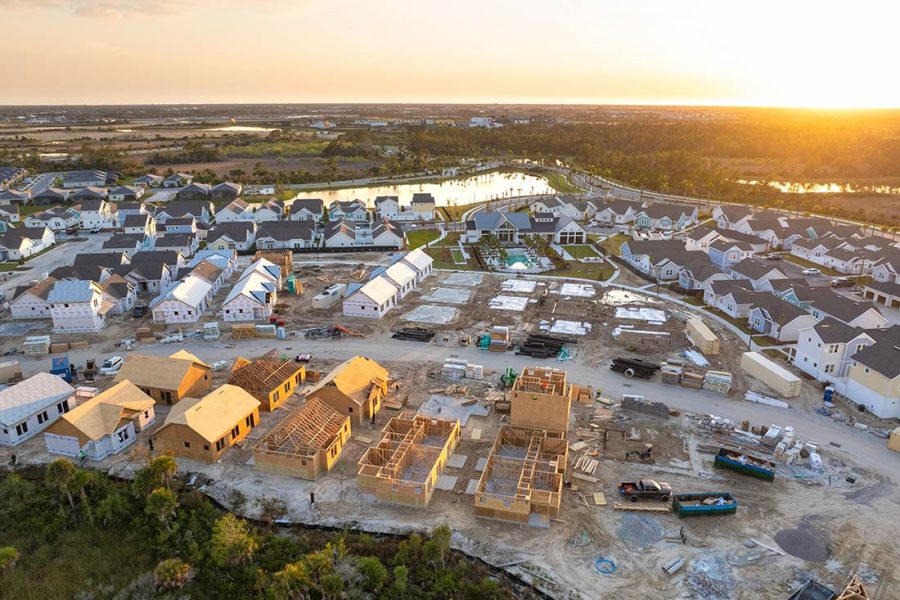- Navigator
- Real Estate Development and Housing
 As economic developers, we hear the same concern in community after community: There just isn’t enough housing available here.
As economic developers, we hear the same concern in community after community: There just isn’t enough housing available here.
The data backs up these concerns: The US had a housing supply gap of between 4 and 7 million homes in 2023. Whether the need is for starter homes, workforce housing, or affordable housing, there are not enough homes in the US to meet current demand.
Furthermore, there are not enough homes located close to people’s jobs. In some areas, employees must drive over an hour to and from work because there is no housing available nearby.
How did we get into this situation?
Where Did All the Homes Go?
According to Alex Horowitz, director of Pew’s Housing Policy Initiative, the current housing shortage can be attributed to several factors, the largest of which is restrictive zoning. These zoning codes and requirements make it difficult to build new homes as the population expands, particularly in areas close to jobs.
Another very modern reason for the housing crisis is short-term rentals such as Vrbo and Airbnb. When people buy houses with the intention of using them as short-term rentals, they take these homes off the market and leave properties standing empty for periods of time. Not only does this impact the culture of the neighborhood and the community, but it also means fewer homes are available for long-term residents and the local workforce.
Lastly, household size in the US has been shrinking over the past 60 years. In 1960, there were 52.8 million households, 40.2% of which had four or more people in the household. In 2023, there were 131.4 million households, and only 21% of them had four or more people.
The change in US household size has a lot to do with changes in our culture. As a society, we have moved away from living with our extended families. We require a significant amount of personal space, and couples are increasingly living together before marriage. All these shifts have spread families out amongst multiple homes, separating what would have once been one home shared by two parents and two adult children (and potentially their spouses and children) into three homes. Household after household, this adds up.
While there are other reasons for housing shortages in the US, these are the causes most often cited in our clients’ communities.
In response to these issues, housing experts suggest changing zoning and housing policies to allow for more housing types and densities and restricting the number of short-term rentals to reinvigorate the existing housing stock.
Expanding household sizes can help improve availability and affordability and may allow people to live closer to work. Homeowners who are struggling to make ends meet but don’t want to downsize or sell their homes can charge rent and/or share bills among household members.
In a world where millions of homes are lacking, adding more people to existing larger homes can be a win-win. It can solve affordability and availability issues by dispersing costs among members of the home and providing housing for those who need it.
Taking a Page Out of Our Housing History Book
During interviews with residents in communities seeking to address growing housing problems, a couple of relics from America’s past have come to mind as ways to relieve local housing pressure by increasing household sizes: intergenerational family housing and boarding houses.
These two ideas may seem as outdated as jukeboxes and penny candy, but they may offer a glimmer of hope in an otherwise dark housing market.
Intergenerational Family Housing
Living with your parents is sooo uncool. But why? It fosters connection, provides much-needed childcare, can save money and disperse costs, and fills a housing need. Furthermore, more than half of adults living in multigenerational homes say it is rewarding all or most of the time, citing both emotional support as well as logistical benefits.
Up until the 20th century, the majority of Americans lived in multi-generational and extended family households. This ceased to be the norm starting in the 1940s and ‘50s when the introduction of Social Security benefits and company pensions allowed retirement-age family members to stay in their own homes.

Three generations of family in front of the house they shared in Massachusetts during the late 1800s. (Source: Digital Commonwealth Massachusetts Collections Online)
In 2021, 18% of the US population lived in intergenerational housing. This number is notably higher for younger adults in America, with about 45% of people aged 18 to 29 living at home in 2023, according to a survey from Harris Poll for Bloomberg News.
This kind of living arrangement might be suitable for families who:
- Have one or more parents not currently working due to childcare needs and a grandparent who could provide that care
- Have an elderly parent who needs some degree of care but does not want to move to an assisted living facility or cannot afford to do so
- Are struggling to afford housing and have family members in the area who could move in and help cover those costs
- Have adult children who cannot afford to rent or buy their own homes due to rising housing costs
Increasing the number of intergenerational households would help meet some of the growing housing demand. It would also provide families with needed childcare so parents can go back to work and reduce financial stress through cost sharing. While this may not be the right choice for every family, sharing your home with your parents, children, grandchildren, and/or siblings can be an excellent way for families to provide financial and caregiving support to each other.
Boarding
If the idea of living with your family sounds like pure torture, then boarding may be a better option.
A boarder is a person (typically unrelated) who lives in someone else’s home and pays for the room they stay in and some portion of the household bills. Boarders are often shorter-term tenants than renters or roommates and share communal spaces with the homeowner, such as the kitchen, bathrooms, dining room, etc.
Boarding houses were common in the US until the 1950s when a housing boom allowed more members of the growing middle class to rent or buy their own homes more easily. In the 1800s, it’s estimated that up to half of all urban residents in the US either rented rooms to boarders or were boarders themselves.
Historical photo taken in 1890 of residents of a boarding house in Tacoma, WA. (Source: Washington State Historical Society, Catalog ID # 1900.56.8)
Unlike renting or leasing, which is usually regulated and operates by a distinct set of rules, boarders and their hosts typically have more flexibility regarding how to split costs and household chores.
Situations in which boarding may be preferable to owning or renting include:
- You are a traveling nurse or construction worker staying in an area for less than a year
- You are new to the area and not yet ready to buy a home
- You cannot afford to rent a home on your salary alone
While living with strangers may seem odd, think of how often we do similar things: We meet up with someone from Craigslist to sell them our couch; we use apps to get rides with perfect strangers and hope they drive us to the address we gave them. As with all of these situations, caution is encouraged when choosing to host a boarder or to become a boarder yourself.
So What?
While we cannot snap our fingers and expect everyone to live together (Housing crisis solved!), we can consider new dynamics around what defines a household and what is considered normal. Living arrangements that were once common practice have now gone out of style and all but disappeared, taking the availability of housing with them.
Perhaps revisiting old housing trends such as intergenerational housing and boarding could be one piece of the puzzle that helps solve the housing crisis in the US. Of course, increased housing construction and zoning and policy changes would also need to occur, but those are topics for another article.
Is your community struggling with housing availability and affordability and looking for practical solutions? Camoin Associates’ Real Estate Development and Housing Team can help. Learn more about our housing-related services.





